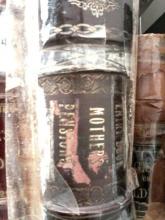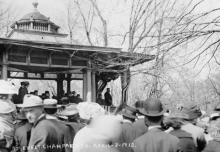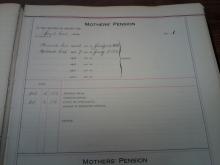In the Archives special collections storage there is an area devoted to the preservation of early governmental records. Originally, the records were handwritten and kept in large red bound books nearly half the size of an adult person. Walking down the long rows of shelves, you can see the spines say Naturalization records, Marriage License Applications and Will records in bright gold block lettering. Towards the very end of the aisle, past dark red and gold bindings is a smaller book amongst the giants with the curious title of “Entry Book Mothers Pensions”. All by itself, this reddish-brown book is a relic from an entire movement in U.S. history.

The Progressive Era in America dated from roughly 1890 till 1920. This was a time of great social change, which stemmed from the idea that the government could be an instrument to better individual lives. The belief was that social ills, such as poverty, would be counteracted with education and government funded programs. Strong supporters of this ideology, such as Theodore Roosevelt, became champions of several movements during this era to create change. The Family Preservation Movement was one agency of social change the President backed.

President Theodore Roosevelt at West Side Park, Champaign, April 8,1912
Prior to the Progressive Era, leaders striving to better society believed that impoverished children and orphans should be separated from the rest of the population and sent west, usually on Orphan Trains. This would prevent the children from being raised in immoral environments. The Family Preservation Movement began as a counter to this argument. Leaders of this ideology believed that the key to social progress lay in keeping families together to nurture and generate productive citizens. Instead of separation, the government would step in to ensure the family unit could remain together giving children the opportunity for education instead of work. As part of this goal, the Mother’s Pension fund was formed to give single mothers a chance to work part-time and supplement the missing income with a government stipend.
Illinois was the first to pass a statewide mother’s pension law in 1911. The funds gathered were primarily used to help widows and unwed mothers who did not have a source of male income. The first entry in the Archive’s “Entry Book Mothers Pensions” dates from October 16, 1916. Petitioner Pearl Cox was seeking aid for herself and her children Howard age 11 and Mildred age 7. Most entries in the book contain the names of the mothers and children receiving stipends and the amounts given per month. Champaign County ended its Mother’s Pension payments in June of 1942. The funds gathered for the program were moved to an account entitled “Care of Dependent Children, other than in County maintained institutions”. At the end, the Mother’s Pension fund had a balance of $3,746.75.

Walking down the aisle, viewing so much history stored between dark red bindings, it’s easy to miss one curiously named book. Yet, this seemingly simple book contains both the history of local families and the broader history of our country.
Lara, Archives Assistant
